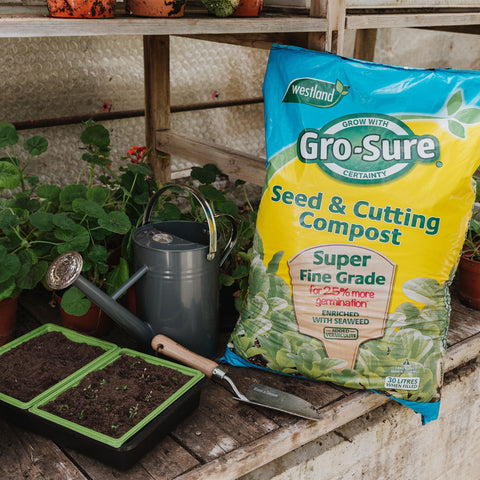Growing new plants from seed is a miraculous and satisfying experience, and one of the great joys of the gardening year. Most people associate seed sowing with spring, but in fact it is a task that, depending on what you are growing, can be done throughout the year. There are various factors which can affect how well seeds germinate and the resulting plants perform. When things do not go as expected it can be a frustrating situation, so there are certain points to consider and techniques to follow.
Compost holds the key
Always choose fresh, top quality, purpose-made seed compost
Seed compost such as Gro-Sure’s Seed & Cutting Compost. This is a super-fine grade blend which ensures closer contact with seedling roots and is enriched with plant extracts for a balanced nutrient supply, resulting in strong germination and establishment. Multipurpose compost is often too coarse to allow even germination, especially of fine seeds, and the nutrient balance may be wrong. Using old compost that has been sitting around for months is always a mistake for seedlings and carries an increased risk of introducing pathogens that will damage or kill the seedlings.

Always store seeds properly
Take care of your seeds and they will respond. If you are planning on keeping a packet of seed longer than a few weeks it is best placed in an airtight, watertight container and stored in the fridge. Kept this way seed viability can remain high for a year or more.
Read the packet carefully before opening
Some seeds have special instructions such as pre-soaking which needs to be done before sowing to ensure good germination. The temperatures and sowing depths are also important to follow if you are to get the most from your seeds – often the packet will tell you other information such as how long it normally takes the seeds to germinate, and of course, the sell-by date. Sowing old seed may still be worthwhile but the results may be less impressive.
How to sow seeds
Scatter small seeds evenly on the soil surface; lightly and thinly is best
You don’t need to press the seed into the soil – doing so can cause erratic germination with some seed if it’s sown too deep or too close together. Seed that is sown too densely usually results in leggy seedlings that are prone to disease and hard to prick out. Do not sow all the seed at once, or use several seed trays. Larger seeds can be pressed more firmly into the compost but make sure you always read the seed packet instructions.

The next steps
Consider using vermiculite
Vermiculite is a naturally occurring lightweight material that absorbs moisture and nutrients and releases them to seedling roots. It also provides insulation allowing healthy seed germination. This works particularly well with very small seeds; sow them thinly and evenly, making sure they are not too deep in the compost then cover seed trays with a thin layer of Gro-Sure Vermiculite and gently moisten.
Always label your seeds
It is easy to forget what you have planted and when – add the date at the same time as the name so you know how long it has taken for the seeds to appear. Use a purpose-made name plant label, rather than shoving the seed packet into the compost… it will quickly disintegrate or get lost!
Cover your seed tray with a propagator lid or plastic bag after sowing
This will keep the environment consistently moist and warm – the ideal conditions seeds like to germinate in. Once the seedlings arise and start to grow away, open the bag at one end or adjust the ventilation slots in the propagator lid to allow some air movement. This will discourage disease and help the seedlings grow strongly.
Frequently Asked Questions
Why are my seedlings tall and leggy? Seedlings grown in too dark a position will soon suffer and become drawn as they reach up to the light which encourages legginess. Badly affected seedlings may not fully recover, so to remedy the situation swiftly move them to a brighter spot, such as beside a greenhouse window.
Why do my seedlings have yellow or discoloured leaves? Your seedlings are probably not getting enough nutrients; always use quality, purpose-made compost, such as Gro-Sure’s Seed & Cutting Compost. Once your seedlings are growing away, after pricking-out and potting on, make sure you add a small amount of plant feed such as Westland Organic Vegetable Liquid Plant Food when watering.
Why do my seedlings have wilting leaves? This could be down to a lack of moisture; your seedlings are probably thirsty. Always keep the soil moist, but don’t overwater as this could cause the seeds and seedlings to rot, another possible cause of wilting. Check to see if soil is wet and has fuzzy mould on the surface. Try using Visiroot seed trays to help with watering, These are made from a transparent material which allows to you easily check root growth and monitor moisture levels.
Why are my seeds slow to germinate? They may be too cold. Put your seed trays on a heated propagator mat to really increase the germination success rate. Another possibility is that they have been planted too deeply; always follow the instructions on the seed packet carefully for best results.
Back to Learn & Grow

